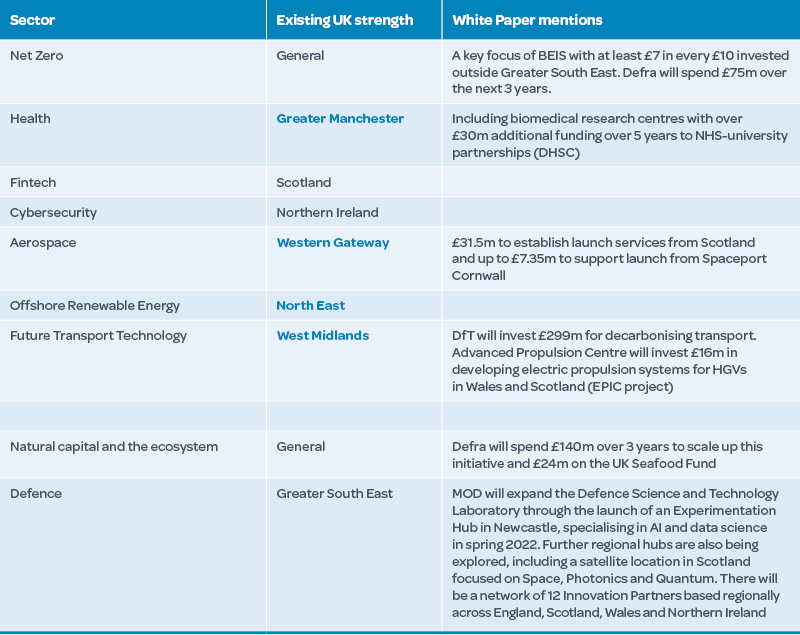Comment
Levelling Up White Paper: Becoming a science superpower
If you had one superpower what would it be? For the UK Government the answer is ‘Science’.
‘The UK Government’s ambition is for the UK to be a global hub of innovation by 2035 and a science superpower’.
The Levelling Up White Paper includes public and private sector investment in R&D outside of the Greater South East as an important factor in the development of ‘Intangible Capital’ - one of six types of capital needed to boost productivity and therefore a core component in narrowing the productivity gap across the country. It appears to move on from the pursuit of ‘ambitious moonshots’[1] in the earlier UK R&D Roadmap[2] and towards harnessing more tangible benefits for the economy and society through economic growth and job creation, as well as sectors which create public good such as Net Zero.
Investment is the Mother of invention
Key to the achievement of this mission is the principle policy aim that:
‘By 2030, domestic public investment in R&D outside the Greater South East will increase by at least 40%, and over the Spending Review period by at least one third. This additional government funding will seek to leverage at least twice as much private sector investment over the long term to stimulate innovation and productivity growth’.
How much of this is ‘new’ investment versus a redistribution of existing funding is somewhat unclear. Regardless, it will help swing the pendulum of high skilled jobs and economic growth to areas outside of the Greater South East, albeit with a considerable and heightened expectation placed on the private sector to contribute funding.
The geography of becoming a science superpower
Of course, no policy priority in the Levelling Up White Paper would be complete without some thought on the geography of impact. The primary intention is to ‘build on centres of expertise’ to generate benefits in economic ‘growth and good jobs in all corners of the country’.
The Government is aiming to ‘expand and support’ existing strengths in clusters around the country, but importantly outside of the Greater South East where the majority of patent applications, high tech patents and income from intellectual property by Higher Education providers (noting the presence particularly of the Oxford and Cambridge Universities), are currently concentrated. It is also intending to develop new clusters.
Some of the specific sectors and investments mentioned in the White Paper are below (this is not an exhaustive list). Areas with existing Mayoral powers/combined authority areas are in blue:

Three new Innovation Accelerators have been identified by BEIS:
- Greater Manchester – health innovation and advanced materials
- West Midlands – future of mobility and data-driven population health
- Glasgow City-Region – Advanced Manufacturing Innovation District
Their selection reflects existing strengths in R&D as well as strong local leadership. Noting two of the three locations have a devolved administration and Mayor suggests that any wider roll out of this programme could focus on other Mayoral city-regions which similarly have the private and public innovation governance required for successful implementation. This could include areas such as the Western Gateway and the North East.
Of course, we are interested in the planning angles of these geographic foci, such as the Government’s support for ‘high-quality research institutions’ particularly given the move away from concentrations of such investment around existing research institutions strengths in the Greater South East. There is currently little meat on these bones and we await the Planning Reforms White Paper.
What we do know however, is that there will be a number of select areas across the country which will be well positioned to be a key piece of the ‘science superpower’ jigsaw puzzle and take advantage of the levelling up agenda for R&D investment. In particular, those with existing R&D strengths or with the organisational benefits of a Mayoral city-region look to gain economic and social benefits in doing so.
Get in touch with Amy Gilham or Jadine Havill for further information.
7 February 2022
[1] A ‘Moonshot’, in a technology context, is an ambitious, exploratory and ground-breaking project undertaken without any expectation of near-term profitability or benefit and also, perhaps, without a full investigation of potential risks and benefits. https://whatis.techtarget.com/definition/moonshot#:~:text=A%20moonshot%2C%20in%20a%20technology,of%20potential%20risks%20and%20benefits
[2] BEIS UK R&D Roadmap (January 2021)